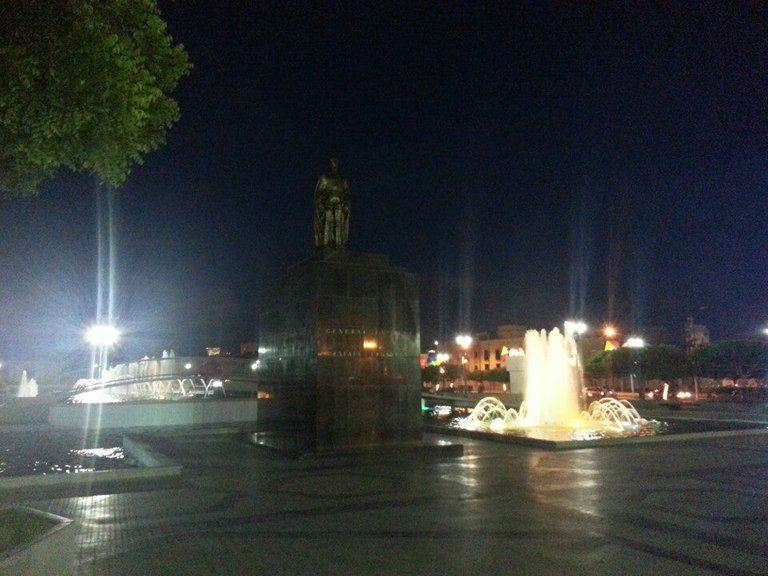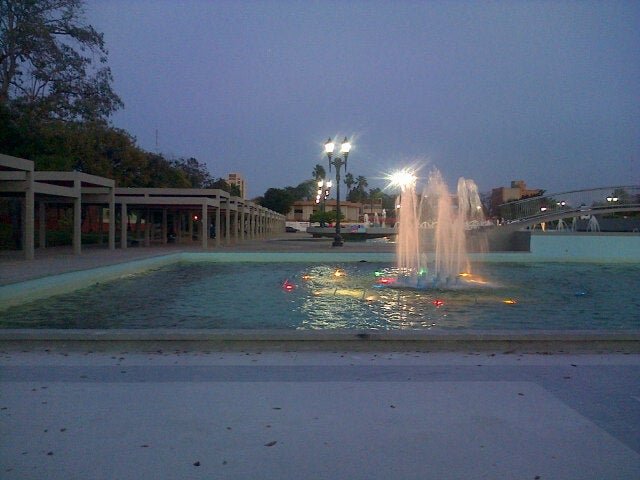
Source
Among these recreational sites in the city of Maracaibo is this one, located between what used to be Padilla Avenue, today Rafael Urdaneta (93rd Street) and 91B Street, and between 7th and 9th Avenues, in the city center.
It was inaugurated in 1972 by President Rafael Caldera on the occasion of the sesquicentennial of the Battle of Carabobo and designed by architect and landscape architect Francisco Oliva.
It can be said that it has two sections, the first, the southern part, separated from the Padilla by an intermediate (service) street where there are two long water fountains separated from a third by a bridge.
In this one, which has a rectangular shape, like all of them, the statue of Urdaneta is placed in the center of it. The first two have wide peripheral spaces where you can walk, run and ride bicycles among many other things and where there are planters with trees and benches to sit.
In front of the third one there is a wide space where the parking lot is located, a roofed area where street vendors of pop corn, cotton candy, toys, streamers and others have been placed at different times, in addition to cart or bicycle rentals.
All the fountains have a multicolored light show that has been a great attraction. At the end of this section on the east side is an old canyon.

Source
The northern zone, which is limited by Av. 91b, is a place full of trees, a communal forest crossed by paths and ideal for camping for a while. In the eastern part of the area there is an open air amphitheater and in the center there is a bridge where there was a pool that was filled in and where a mangrove tree was born.
This park is adjacent to the first Plaza Urdaneta built in 1888 on the first centenary of Urdaneta's birth, in the place that was called the circus, in an extension of 100 meters where a statue made in bronze by the Italian sculptor Giovanni Turini was placed.
It was rebuilt in 1926 and was a popular entertainment site for a long time until 1972 when it was demolished and the Sopotocientos center was built there.
The current space of the park was originally designed to house the Palace of Justice and for this project 150 houses that occupied it were demolished in 1963, but this was not carried out. Later, with the demolition of the Saladillo, the Great Urdaneta Park was planned, which would include the Liberator Center among its spaces, but it was not even started.

Source
The equestrian statue placed in the park at its opening and that remained until 1988 was made by the Italian artist Hugo Dani. It was moved to Punta Iguana at the head of the bridge on the bicentennial of Urdaneta's birth, where it remains and was replaced by a replica of the one in Paseo Los Próceres in Caracas by Ernesto Maragall, of Catalan origin.
In the last years this park has been taken for the realization of the handicraft fair in the days of celebration of the chinita and as epicenter of the ignition of the lights of the Padilla, carried out by the governorship of the State. It is a place of obligatory visit for the tourists.

Source
Your content has been voted as a part of Encouragement program. Keep up the good work!
Use Ecency daily to boost your growth on platform!
Support Ecency
Vote for Proposal
Delegate HP and earn more